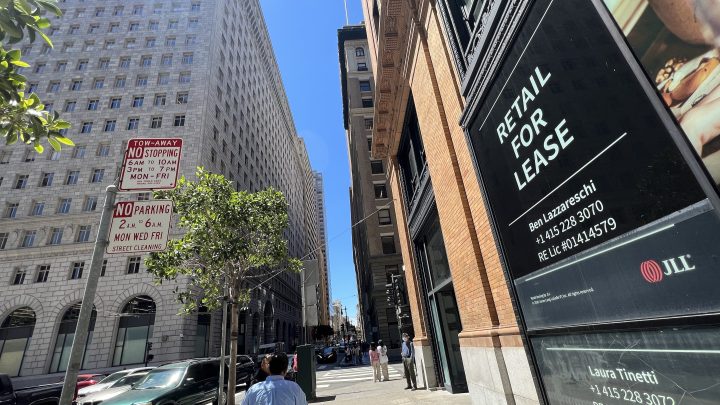
San Francisco struggles with downtown recovery

California is one of the five biggest economies in the world. Among cities in California, downtown area recovery since pandemic lockdowns hasn’t been uniform. Analysis of mobile phone geolocation data by the University of Toronto shows Fresno, California, is recovering better than most cities in the country. San Francisco is at the bottom of the list.
In fact, as far as San Francisco’s downtown is concerned, it might as well be the peak of pandemic lockdowns. Geolocation data shows the same level of foot traffic now as in late March 2020. And that’s left local businesses struggling.
Like Roberto Perez and his shoe repair shop. Before the pandemic, he enjoyed brisk business, with 30 to 50 customers a day.
“Now, like 3, 4, 5 customers at the maximum,” Perez said.
That’s because most office workers are gone.
San Francisco spent decades gearing its downtown toward office space — corporate headquarters, law firms, financial institutions. Over the last decade, the tech industry moved in, too. All jobs that lend themselves to remote work.
“Eighty percent of San Francisco’s economy is made up of office industries,” said Ted Egan, the city’s chief economist. He said the shift to remote work has had wide-ranging and detrimental effects in the city.
“We’re not seeing the downtown office worker traffic,” he said. “It’s also affecting the housing market, business tourism industry. It’s affecting transit and city operations, and small businesses downtown.”
But not all small businesses.
Bix — a downtown institution — may show the city a way forward. The restaurant’s customers are back. The kitchen is humming with activity.
“I don’t think we’re going anywhere anytime soon,” said executive chef Anthony Tadeo. “Having a reputation and being a classic of San Francisco definitely helps. We have customers who have been coming here the whole 35 years.”
This is an example of the cultural and social draws other cities are focusing on. They’re trying to remake their downtowns as not just places of work, but also of play.
“The idea of the office district is now obsolete,” said Karen Chapple. She is the director of the School of Cities at the University of Toronto, which is the organization that analyzed geolocation data to see which downtowns are reviving and which are stagnating.
“We need something else,” said Chapple. “And we want to think about it as an inclusive place, as an affordable place, as a place where you can do all kinds of activities.”
Reimagining downtowns will require a lot of change, she said.
Much like companies which may be trying to reduce their footprint, such as online fraud detection company Sift. Chief People Officer Liz Kosinski said Sift’s current office is meant for about 200 employees.
“This was pre-COVID of course,” she said. “Now we have probably about 100 people who are still in the Bay Area.”
Sift signed a seven-year lease in late 2019. So the company will have to wait several more years before it can potentially downsize.
As more companies take similar steps, that could finally encourage rezoning and new uses for San Francisco’s downtown.
There’s a lot happening in the world. Through it all, Marketplace is here for you.
You rely on Marketplace to break down the world’s events and tell you how it affects you in a fact-based, approachable way. We rely on your financial support to keep making that possible.
Your donation today powers the independent journalism that you rely on. For just $5/month, you can help sustain Marketplace so we can keep reporting on the things that matter to you.











